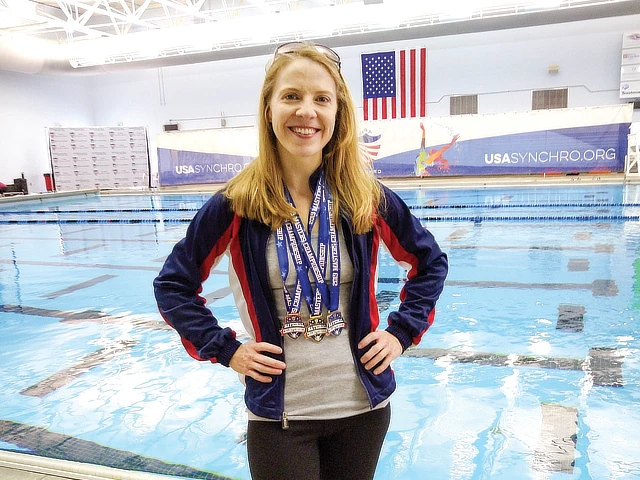
Sometime around 2010, Vicki Valosik ’02, an international relations alumna of Howard College of Arts and Sciences, was casting around for a different way to spend time outside her job at a Washington, D.C., nonprofit. With her love of being in the water and years of dance lessons, synchronized swimming came to mind. So, she signed up for a class at a local pool.
The class, Valosik discovered, was a group of women who had done water ballet or synchronized swimming in the past and got together to practice their moves for fun and exercise. They welcomed Valosik with open arms. “They were delighted to have a newcomer, and they set about teaching me the foundational positions and propulsions,” she said. “I was blown away at how difficult it was to work against gravity and buoyancy in a foreign element.”
But she quickly got the hang of things.
After the 14-week session ended, one of Valosik’s classmates invited her to a practice session of Washington’s DC Synchromasters, a competitive group of synchronized swimmers ranging in age from 20 to 70 years old. Valosik soon became a member. “From the first practice I was hooked,” she said. “Now more than a dozen years later, I am still competing on the team.”
But as she mastered the physical and performance aspects of synchronized swimming, she also developed an intellectual interest. “I began my research partly because of my curiosity as to whether synchronized swimming had begun as a sport or a performance,” she said. “As a practitioner, I could see the tensions between the two.”
In the process, Valosik discovered overlaps between the development of synchronized swimming and the histories of women’s swimming, lifesaving, the Red Cross, physical education, vaudeville and cinema, Title IX and more.
“I realized I had landed on something bigger than the history of a sport,” she said. “It was a story of women’s empowerment in the water that had never been told.”
To tell that story, Valosik wrote a book, Swimming Pretty: The Untold Story of Women in Water, which was published this summer. In it, she relates the progression of synchronized swimming from “just bathing beauties” to becoming a major competitive sport.
Through her efforts, Valosik hopes readers will gain an appreciation for the trailblazing athlete-entertainers who paved the way and whose impact extended far beyond the water.
“Every step of the way, these swimming women defied society’s rigid expectations of what was proper and possible for their sex,” she wrote in the book’s prologue. “Any American woman who enjoys swimming today has these women to thank for parting the waves.”
This story was first published in the summer 2024 issue of Seasons magazine.
